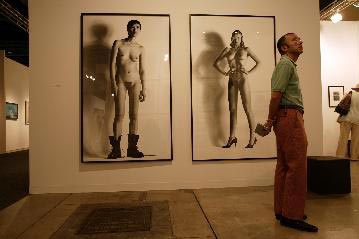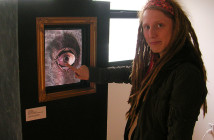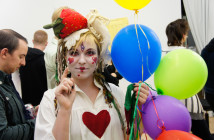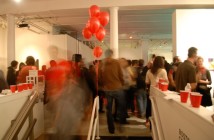For the first week in December, the art world’s elite descended upon Miami Beach for Art Basel 2004. Several smaller fairs including Miami Scope and NADA gave art lovers plenty to look at. The entire Miami art scene was involved with nearly every local gallery and museum holding an event or reception coinciding with the event. The local government, the news media and much of the general public were involved. So the question arises, Why not us? Why not Boston?
The main event, Art Basel is held twice annually, summer in Switzerland and winter in Miami. Only the best of the best can be here, with 136 of the world's top galleries selected from 530 applicants, showing the A list of contemporary blue chip art. The entire event was full of big corporate sponsorship and was catered to the exclusive world elite of collectors. Held inside the spacious Miami Beach Convention center, those who attended paid $50 for a three day pass, and there was definitely a lot to see. I was fortunate enough to get in for free with a press pass, which also included the $40 catalog, which offset the $5 one had to pay for a cup of coffee and $12 for sandwiches inside the convention center, thank you very much. For me the event was a lesson in art history, a chance to see the work of just about every artist of note from the last 40 years up close. All of those Art Forum ads brought to life. It was exciting to see all of this work in person, especially since I have yet to see the recently reopened MOMA but I found myself eagerly searching for something fresh. The real draw was the diversity. New York dealers obviously dominated, but other galleries from California, Texas, Europe and South America had plenty of interesting artists that were a change of pace from what one would see in Chelsea. It is worth noting that there were no Boston dealers that made the cut at Art Basel, the only Boston presence there was O.S.P., the publishers of New American Paintings who were corralled in a small booth in a section with other magazine and book dealers.
Art Basel also had several sideshows, smaller exhibits with a specific focus, There was one dedicated to film/video art and another that was set up as an ongoing series of lectures panel discussions and the like. At the Convention site one row of about 20 booths was set aside and dubbed "Art/Nova" that featured solo shows from up and coming artists. Always looking for something new it certainly caught my attention but did not overly impress, still I took notes on who I think will actually make it, and who is just pop/art trash, getting all the buzz this week. There was an off site exhibit called "Art/Positions" which placed a row of 15 cargo trailer containers along Miami Beach, a few blocks from the convention center. While it seemed to be a promising concept, this part of the exhibit fell far short. Several well know galleries and artists were located here but the presentations and the overall look all rather roughly done inside the plain cargo containers just seemed flat and lacked anything to connect it all together. In an attempt to liven things up several performance and installation artists were intermixed with the scene but all were dull, uninteresting affairs and dated as if it was all taken out of some 1970’s contemporary art textbook. As with most of the rest of Art Basel It seemed obvious it was all an attempt from organizers and dealers to cater to their exclusive clientele’s precious needs and fat checkbooks by not being too far ahead of the curve or at all thought provoking, while denying the rest of us any new work with real substance.
A few blocks from the Miami Beach Convention Center was Scope Miami, Art Basel's main competition during the week. For the younger and more fun going crowd Scope was the place to be, with many of the galleries and exhibiting artists from the newer generation. It was also much more affordable with just a $5 admission and another 5 for a rather well done catalog of the exhibiting dealers Scope Miami was similar to the Scope Fair held this past spring in New York City last year, the idea was simple and effective, the entire TownHouse Hotel on Miami Beach was taken over, and each room was a different gallery, many rooms still had beds and other furniture mixed in with the installations of art. Some rooms were used as solo shows for a single artist, while others were more salon style affairs displaying as many works as possible. Interestingly many of the bathrooms in each of the rooms featured video projections, installations, or some of sort project space, but most lacked as works of art, too obvious an attempt to try and have fun and cute using the space. Unlike the presentation at Art Basel, many of the galleries were approachable and certainly on the level where I felt I could collaborate with some of these people on future projects. Most of the dealers and many artists were present to talk about their works and just be a part of the ongoing discussions. It was very inspiring to be able to see such a large cross section of artists from all over the world in one place and to have direct access to them. It was also surprising to see Boston somewhat fairly represented at Scope, with Bernard Toale Gallery and Miller Block Gallery showing off its best artists. Mixed throughout the halls of the hotel and outside on the street were performance artists of all sorts interacting with the crowds, as well as others just there crashing the party, so to speak. Local artists were selling their own works on the sidewalks and one group of artists parked a Winnebago in front of the hotel with installations of video art inside, all of which made for an entertaining atmosphere. In the evenings there was certainly no shortage of loud music, good wine flowing, and general mayhem all around the hotel site.
A cab away from Miami Beach in what was a completely desolate and abandoned area of Miami, was the New Art Dealers Alliance fair. NADA was a bit of a cross between Art Basel and Scope. Held in a warehouse some 40 dealers were each given generously sized stalls in which to display work. Like Scope, there were Boston connections here as well; Allston Skirt was a featured dealer. I also noticed several former Boston area artists sprinkled about being represented by galleries in New York and elsewhere. Again like the Scope fair there were artists from many of the galleries present, and the majority of the dealers were willing to talk to people in depth even if their checkbooks were not in plain view. Unlike Scope, this was a more relaxed atmosphere, perhaps the isolated location helped keep a lot of those just looking to party away, a large lawn with plenty of hammocks strung between palm trees was the perfect place to hang out and relax and check out some great art. NADA tended to be of a be a tighter and more polished level than what was presented at Scope, although overall there were a lot of excellent examples of emerging and mid-career artists to be found at both sites.
In between all of these art fairs there was so much else that I took in, the Miami Museum of Modern Art along with most of the local galleries, along with several private and corporate collections all had openings and events tied into the fair; many of which I visited. And of course there were the all night parties with the art world elite, held at exclusive clubs and hotels, all over the city. I went to a few of these events that were on my rather long list, but to me an opening or a party is pretty much the same wherever it is, just in Miami they do it on a much larger scale. And with only a couple of days in town and so much to see during the day it is hard to get too crazy at night.
There were a few things I did not get to see during my trip, including a fourth smaller collection of galleries known as FRISBEE, which emphasized emerging non-commercial, and non-profit groups. I read a couple of good reviews of it in the local Miami press, and would have loved the chance to see it. Oh well, I tried, but even I cannot see it all, and people say I see a lot.
Both Scope and NADA have given me lots of new material to work with and I certainly enjoyed the opportunity to see so much interesting work from around the art world. My collection of postcards and catalogs grew considerably and I will enjoy sorting out the bunch and keeping track of many of these artists in the hopes that I may use some of them in a future exhibit I curate. The entire experience of being in Miami while the entire city was alive with the arts has also helped refine and shape my own personal views of Boston and its role in the larger art world, and to a smaller extent my own role in all of this as well.
Upon leaving the beautiful sunny 85 degree weather in Miami and returning to a cold rainy Boston, the only question on my mind is, why not us? Why not Boston? Obviously Boston is not the resort destination that Miami is, and Revere Beach with Kelly’s Roast Beef doesn’t quite compare to Miami Beach and it rows of waterfront Art Decco Hotels and exclusive restaurants. Boston may not be the playground for the rich and famous but it does have a lot to offer and is consistently on the top of lists of tourist destinations and is noticed for all of its rich history. Mayor Menino’s ultra aggressive redevelopment of the Boston waterfront is designed to attract businesses and trade conventions, and includes the new building for the ICA, a big step in the right direction. With the new hotels being finished, and more businesses setting up shop, and the last of the leaks of the I-93 tunnel maybe someday being sealed, there will be an impressive waterfront district of new development unlike anything seen in this city in our lifetime. As Boston’s standing as a world-class business center grows, its standing in the arts should grow to a larger level as well. In a few years when the ICA is finished and the rest of the infrastructure is complete, I do not see why there is any reason that we cannot host something on the scale of Scope or NADA to help put Boston's name on the national map.
Of course I am getting a bit ahead of myself, there is a lot to be done before anything of that nature could happen here. However, I believe most of the pieces are all already there; they just need to be put together. We need to organize and address a wide range of issues before we can move on.
First, communication needs to be improved, especially between those of us within the art gallery world. A couple of well established organizations do already exist that help organize and network. There is the Boston Art Dealers Association, which includes some, but definitely not all of the commercial galleries. Among other projects BADA established the Stephen D. Payne Scholarship, which is celebrating its 5th anniversary this year. This important award has supported many of the areas top emerging artists in finishing their art school careers.
Perhaps the best known effort to network and collaborate between galleries and other venues is the Boston CyberArts festival, which is a remarkable event put on every two years, that includes a diverse cross section of artists and arts organizations, both non-profit and commercial, from across Boston and Cambridge to showcase some of the best new media and technology based artists in the country. Boston is way ahead of things with new media based art, a fact that was noted by several artists and dealers I met in Miami, and it is wonderful that there is something in place to celebrate that.
A bit of an offshoot of CyberArts is, AT Boston, about a year old this collective of a dozen or so new media based galleries and artists groups has done a lot to network as well as lay the groundwork for future collaborative efforts and has done a lot of good things promoting the alternative scene in general. The one issue with AT Boston and CyberArts, is that their charters dictate that it is for galleries and organizations with an interest in new media and technology based work. While it is a really great thing to have and certainly an impressive and important step, it is not all inclusive of the art scene.
What we really need is a way to connect the dots. If Boston is ever to stand a chance of showing a presence on a national level, we need to establish a way for those with resources to network and connect with those with the ideas and drive to make it all happen. There is an ever-growing list of alternative and non-profit venues as well as commercial spaces looking for a way to connect to the rest of the art scene. Having worked on both sides of the fence for 10 years, I know first hand, numerous examples where commercial and non-profit galleries cross over, both in the work shown, and the issues faced to operate as a business. We all have a lot more in common than most people realize. I have seen plenty of commercial gallery directors looking more and more at what the alternative scene has to offer. Several for-profit galleries are taking chances showing work from new and emerging artists and artists working in more experimental directions that have little commercial potential. There needs to be a way for all of us to easily share ideas, trade resources, collaborate on group-based projects, and to keep in touch and informed with what we all do.
Sometimes it is the simplest of ideas that help move things forward, I certainly applaud Big Red and Shiny for its efforts to increase critical dialog. It is also a great resource for finding out about the scene, check out the events listings and venue listings elsewhere on the site.
Over the years I have taken several approaches to address these issues. About 5 year back I was the Director of Gallery fx on Thayer Street in Boston’s South End. At the time things were brand new and there were just 4 other galleries on the street. We had very little communication between us and each space held different schedules for exhibits and openings and few people would show up. At one point when the other gallery owners and I met for coffee, I suggested the idea of coordinating our openings at the same time to help improve traffic to the neighborhood and to introduce new audiences to each of our spaces. The result was the start of the First Friday openings. Thayer Street has since exploded and now features nearly 20 galleries and hundreds of visitors checking out the scene the first Friday evening of each month. (Unfortunately without my now deceased former gallery…)
Around the same time I organized a pot luck get together which included nearly all of the then existing alternative art galleries and organizations in Boston. While it had a promising start, Art Initiative had a lack of focus and direction, and perhaps coupled with bad timing feel apart after a few increasingly chaotic meetings. Still, I feel pretty good knowing how far we have all come since then. While the Art Initiative soon disbanded, many of the connections and people I met through that are the same people I am working with today and I know I am much better off for the experience.
This past summer, I set out to test more of these ideas of communication and collaboration, when I realized that six different non-profit venues were hosting exhibits related to the Democratic Convention. I organized an effort to network and do a bit of cross promotion between us. On some levels it was a great success, we did receive press, recognition as a group, and at the very least it gave us a chance to work together as a community; however, I am a bit disappointed that the momentum from that effort has not continued.
Boston has a great art community with a lot to see and do, the problem is that we are not all talking to each other yet. Lets be serious, If we cannot talk between ourselves in our own community what chance do we possibly have of working on a larger scale with the City, State, and other agencies or having any sort of a unified voice in the larger art world?. Only by organizing and working together can we have a voice to take on important issues such as long term sustainable funding, finding stable venue spaces and other critical issues. Maybe more of the media will finally notice us and dedicate more print to actual critical discussions about exhibits and events, if they realize there is an actual network and working community of galleries and venues in this town. Who knows what else can happen if we are actually talking to each other. It's time for these things to move forward.
It is certainly a labor of love to stick with these things, but those of us trying know that the end results will benefit the entire art community and only positive things will come from that. It has been proven time and again that the community is too small for us not to work together. Only by improving our networking, communication, and collaborating to take on our common issues and goals can we build a true local art community that will be recognized as a part of the larger art world. The pieces are there; it's time to start putting them together.
Links:
Art Basel Miami Beach
Alternate Currents
All images are courtesy of Art Basel Miami Beach.
James Manning is a Boston based curator, exhibit installer and artist. In 2004, James graduated with a BFA from Suffolk University and is currently the curator for Alternate Currents. You can find out more about his current projects at artvigor.org




